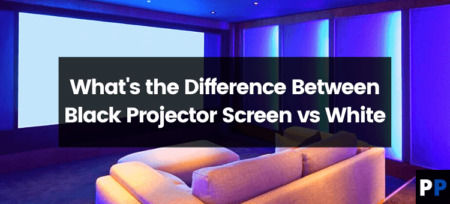So, most of you guys were asking me to please tell us what’s the difference between DLP, LCD, LED, and LCOS? So, I decided why not write a brief article on this. Therefore, today in this article I will explain to you each and everything about these screens in a very detailed manner. So stay tuned with me.
What are a DLP Projector and Its Benefits
A DLP, also known as digital light processing or projector, uses tiny mirrors reflecting light on the screen. It’s usually an actual color wheel, a real spinning wheel full of color filters that produce sequential colors. They are available as DLP projectors with a single chip or DLP projectors with three chips that include green, red, and blue-chip DLP. DLP projectors are the most popular home theater projection that uses DLP technology.
Light output from DLP projectors is generally sturdy and is suitable for areas with ambient lighting like classrooms and conference rooms. In the same way, color accuracy is variable but varies considerably depending on the projector is often the best when using DLP projectors. Motion blur isn’t a huge problem with most DLP projectors.
They produce crisp, sharp images when you watch rapid-motion scenes in action films and sports. But, DLP projectors may be plagued by rainbow artifacts, where bright objects can create the illusion of some light trail. This isn’t an issue with 3-chip DLP projectors. However, single-chip DLP projectors may be affected by artifacts.
REASONS TO BUY
✓Excellent color precision
✓Realistic images
✓Ideal for gaming and other uses for individuals
✓Minimum blur motion
REASONS TO AVOID
✗It’s got a mirrored chip which reduces its pixels
✗It flashes colors on the screen as it tries to recreate the rainbow effect.
What is an LCD Projector and Its Benefits
Although LCD, also known as liquid crystal display technology, is used in TVs and monitors for computers, it’s also widely used in projection. LCD projectors have three LCD panels, which project images using three primary colors: blue, red, and green.
The three panels are projected simultaneously to ensure that the final image can be displayed in full color. The cost varies in price, ranging from just a few hundred dollars to top of the line of thousands.
Most of the time, LCD projectors are pretty affordable to run since they don’t have moving components. The life of the lamp is usually greater than DLP projectors. High-quality color accuracy, and there’s a decent amount of energy consumption.
The black levels shine, and light output or lumens could be pretty high. Rainbow artifacts are reduced to an absolute minimum, although motion blur could cause problems.
REASONS TO BUY
✓Simple to use and keep up
✓Excellent quality of light output and color accuracy
✓Superb black levels
✓Low power consumption
REASONS TO AVOID
✗LCD could have severe problems regarding motion blur
✗A weak or insignificant rainbow effect
What is an LED Projector, and Its Benefits
LED is a popular term in the field of lighting technology. It stands for the light-emitting device. While DLP, as well as LCD projection systems, refer to technologies for projection, LED concentrates on light sources.
In reality, LED projectors can employ LCD or DLP technology. Instead of a traditional bulb, the LED projectors employ high-efficiency bulbs that significantly extend the life of lamps. Instead of the usual 1,000 to 5,000 hours of lamp life typical of projectors, LEDs have a lifespan of up to 20,000 hours.
Similar to LCD and DLP projectors, these could be extremely affordable or even empty your bank accounts. Motion blur, black levels, and color accuracy artifacts depend on the projection sources, DLP, as opposed to LCD.
However, the maintenance of LED projectors is less costly since they have a non-filtering design and a long lamp lifespan. My BenQ ZTE Spro2 and GV1 projectors are LED-powered devices made with the LED source of light as well as projectors using DLP.
REASONS TO BUY
✓Extended lamp life
✓The most affordable to purchase and maintain
✓Flexibility through levels of black, color blur, and motion precision
✓Efficient energy
REASONS TO AVOID
✗It’s not particularly useful in the home or for other personal use
What is an LCoS Projector and Its Benefits
LCoS, also known as the liquid crystal-on-silicon, is a kind combination of the LCD and DLP. It is based on LCoS and utilizes liquid crystal chips with reflective backs like DLP. However, it is an LCoS projector that transmits light to LCD panels that are altered through liquid crystals.
It’s reflective technology and one that uses LCDs over mirrors. There aren’t even any SVGA LCoS projectors, and the resolution is significantly greater. But mass is lost as a result. The lightest LCoS projectors weigh more than 10 pounds. LCD, DLP, or LED projections are more mobile. The projectors from JVC and Sony use exclusive LCoS technology, D-ILA, and SXRD, respectively.
I have a massive Sony VPL-VW60 theater projector with LCoS technology built into it, and even though it’s not as mobile as My ZTE Spro2 or BenQ GV1, it delivers top-quality image quality with stunning color reproduction and stunning black levels. The price tends to be somewhat higher in the hundreds of dollars, typically at the higher end of the spectrum.
Videophiles are drawn to LCoS projectors and the contrast ratio, an essential specification for image quality, is the reason. Performance is excellent and black levels are unique with deep blacks and vibrant whites.
Light output can vary depending on the model, with some older LCoS projectors having very low lumens, while the latest LCoS models offer large lighting output. However, motion blur, similar to LCD projectors, can be a problem, but there are almost no rainbow artifacts.
REASONS TO BUY
✓Realistic images
✓There is a very low or zero chance of pixel blur
✓Fantastic motion precision
✓Excellent contrast ratio and plenty of black levels
REASONS TO AVOID
✗It’s heavy and therefore not mobile
✗It’s relatively costly
Differences between LED, LCD, DLP, and LcoS
In the beginning, you must be aware of the specific features of each projector so that you can discern their distinct features. Are you concerned about knowing the particular characteristics of these kinds of projectors?
One thing to remember here is that the significant distinctions between these projectors are the kind and the quality of media they use. Different projectors produce media of diverse quality, employing various techniques, and therefore are suitable for various uses.
Let’s now we will look at the factors that are responsible for their distinctive characteristics.
Factors
There are some factors which you need to consider before making a firm decision about their differences.
Contrast Ratio
A projector’s contrast ratio projectors are the primary factor in the quality of images. It plays a vital role in the dimensions and depth of output images from any projector.
The contrast ratio is the difference between two extreme pixels, the dark and white pixels. DLP projectors have the highest contrast ratio. This attribute is responsible for their ability to be used in home theatres and games.
LCoS follows closely with an excellent ratio too. The LED or LCD projectors work great for large-scale gatherings.
Color
Color is a crucial aspect of the screen. It affects the aesthetics of the output.
There are only minor differences in the colors of images generated by various projectors.
Different brands, models, and models have distinct color characteristics. You will always find them listed in the manuals of the projectors.
Brightness
It is the brightness that a projection device has. These can be called lumen ratings. It is the most critical indicator of the output of the projector.
The output of light sources for projectors depends on the projector and model. DLP produces the lightest overall, according to the analysis.
But, the latest version of different types of projectors incorporates features to increase their brightness.
Rainbow Effect
As the name suggests, the rainbow effect aids an image made by a projector to emit multiple colors with the perfect blend.
Therefore, DLP offers a more vibrant rainbow effect than LCoS and LED since it employs an actual color wheel, whereas LED doesn’t.
Apart from those mentioned above, additional notable features include motion blur, screen door effects, dust resistance, and convergence.
Conclusion
The specifications of different projectors differ according to the individual’s needs. Each type has strengths and drawbacks.
LCD, LED, DLP, and LCoSprojectors are based on factors that differentiate these three types of projectors. These differences are evident in their use and function.
So, the selection of a person is based on desirable and appropriate attributes.
Their characteristics, pros, and pros and cons will assist you in making the best choice for your requirements by evaluating the differences in the various types of projectors.













